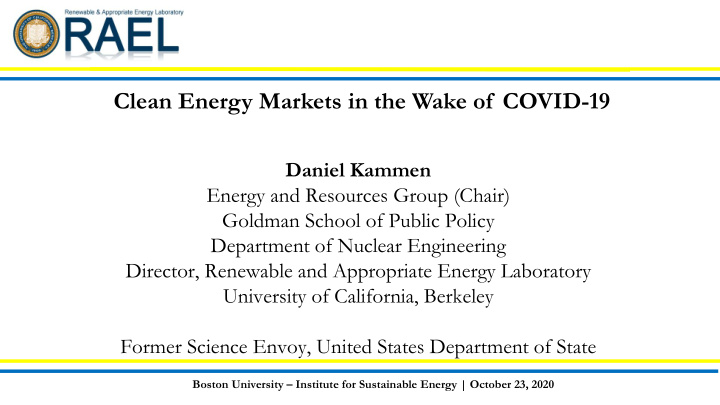



Clean Energy Markets in the Wake of COVID-19 Daniel Kammen Energy and Resources Group (Chair) Goldman School of Public Policy Department of Nuclear Engineering Director, Renewable and Appropriate Energy Laboratory University of California, Berkeley Former Science Envoy, United States Department of State Boston University – Institute for Sustainable Energy | October 23, 2020
The Impact of COVID-19 on Energy Use and Emissions Coal use - 10 % globally since January Gas use - 4 % globally since January Green energy + 3 % globally since January Figure 1 Daily CO 2 emissions Q1 of 2019 (dotted line) and 2020 (Solid Line) Nature Communications https://www.nature.com/articles/s41467-020-18922-7 http://rael.berkeley.edu
California Energy Goals: Aggressive & Evolving 50% 60% 33% 20% 2013 2020 2030 California Senate Bill 100: 100% clean energy by 2045 and 2030 standard now 60% (without nuclear or large hydro) 4
9.23.2020 - China to peak emissions by 2030, 9.22.2020 - California has peaked emissions, & carbon neutral by 2060 will now end internal combustion sales by 2035 5
More solar jobs in California than fossil fuel jobs More solar jobs in California than utility jobs. Schmitt, Kittner, Kondoff & Kammen (2019) Nature , 569 , 330-332
The Learning Curve Swanson’s Law “Moore’s Law” −𝑐 𝐷 2 𝑊 2 = 𝐷 1 𝑊 1
Materials Science for Storage Innovation Data from: Schmidt, O., Hawkes, A., Gambhir, A., & Staffell, I. (2017). The future cost of electrical energy storage based on experience rates. Nature Energy, 2, 2017110. Qiu, Y., & Anadon, L. D. (2012). The price of wind power in China during its expansion: Technology adoption, learning- by-doing, economies of scale, and manufacturing localization. Energy Economics , 34 (3), 772-785. ;
Solve Climate by 2030: Can We? Energy economics say we can Overnight Energy costs: $0/tCO 2 Nuclear Gas Wind Solar Gas http://rael.berkeley.edu
Solve Climate by 2030: Can We? Energy economics say we can California & Quebec: $20/tCO 2 http://rael.berkeley.edu
Solve Climate by 2030: Can We? Energy economics say we can Social Cost of Carbon: $50/tCO 2 http://rael.berkeley.edu
Under the Radar, but Over the Moon http://rael.berkeley.edu
California Energy Efficiency Strategies: Policy Drives Innovation Residential New Construction • All new residential construction in California will be zero net energy by 2020 .
California Energy Efficiency & Solar Policy Drives Innovation Residential Construction Zero net energy after January 1, 2020
Big Bold EE Strategies Commercial New Construction • All new commercial construction in California will be zero net energy by 2030 . • Leverage opportunities from emerging technologies initiatives, incentive programs, and local initiatives targeting commercial building/ property developers.
The World’s Largest Iron -Chromium Flow Battery EnerVault Iron-Chromium Technology 1 MW-hr capacity at 250 kW (4 hour duration) Turlock, CA 16
California Advancing Energy Efficiency
Dr Cheng Zheng, CEO, Aspiring Citizens Cleantech (ACC) & Gordon Bauer (ERG, UC Berkeley) Target: 100% EV taxi fleet in Shenzhen, China (28,000+ vehicles) 96% of the taxi fleet
Racial disparity is observed – even at same income No majority 21
Racial disparity is observed – even at same income White No majority Hispanic Black 22
23
Learn from our Mistakes: The need for Environmental Justice • Lack of solar power and electric vehicle access where the health benefits are highest • California Green New Deal: Dedicated seed fund of $3.5 billion/yr for disadvantaged areas • One California proposal (not yet passed): affordable housing at transit hubs. http://rael.berkeley.edu
Electricity • System Architecture ~200 kW PV DC microgrid based on utility backbone with single inverter connection to the grid Charging stations for shared EVs – or Individual charging stations 10 x 25 kWh/10 kW flywheel storage • Estimated ~250 to 300 MWh/year PV production.
RAEL partners with Shenzhen to use the Internet of Things (IOT) to reduce waiting times for EV recharging
Many Opportunities: The Green Stimulus https://medium.com/@green_stimulus_now/a-green-stimulus-to-rebuild-our-economy-1e7030a1d9ee Author team: Johanna Bozuwa, J. Mijin Cha, Daniel Aldana Cohen, Billy Fleming, Jim Goodman, Ayana Elizabeth Johnson, Daniel M Kammen, Julian Brave NoiseCat, Mark Paul, Raj Patel, Thea Riofrancos (2020) “A Green Stimulus”, https://medium.com/@green_stimulus_now/a-green- stimulus-to-rebuild-our-economy-1e7030a1d9ee http://rael.berkeley.edu
Resources: http://rael.berkeley.edu @dan_kammen http://rael.berkeley.edu
FEEDBACKS AMONG ELECTRIC VEHICLE ADOPTION, CHARGING, AND THE COST AND INSTALLATION OF ROOFTOP SOLAR ROBERT K. KAUFMANN DEREK NEWBERRY XIN CHEN SUCHARITA GOPAL In Press Nature Energy
PANDEMIC DIMINISHES THE ROLE OF ECONOMICS • Trust in science • Home improvement • Self-sufficiency
RELATIONS PV, COSTS, EV, & CHARGINING STATIONS
Rooftop Solar ↔ Electric Vehicles • Environmental complementarity • Visibility • Social norms
R ooftop Solar ↔ Installation Costs • Learning by doing • Lower costs enhance installation
Electric Vehicles & Charging Stations • No relation • Range anxiety • Housing type • Charging equipment
Policy Implications • Space Matters! • Trigger decision-making • EV subsidies by zip code • SREC conversion efficiencies by zip code • Feedback Multiplier
Recommend
More recommend